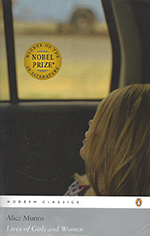 Alice Munro has a way of deflating things usually thought majestic, and granting majesty to things normally thought small and plain. I tweeted that earlier this month, and the passage that got me thinking about it was the opening of a section[ref]Chapter?[/ref] called “Changes and Ceremonies” in which Del and her friend Naomi become wrapped up the mythology of both sex and art, entering puberty and acting in the school play. It is an amazing thing:
Alice Munro has a way of deflating things usually thought majestic, and granting majesty to things normally thought small and plain. I tweeted that earlier this month, and the passage that got me thinking about it was the opening of a section[ref]Chapter?[/ref] called “Changes and Ceremonies” in which Del and her friend Naomi become wrapped up the mythology of both sex and art, entering puberty and acting in the school play. It is an amazing thing:
Boys’ hate was dangerous, it was keen and bright, a miraculous birthright, like Arthur’s sword snatched out of the stone, in the Grade Seven Reader. Girls’ hate, in comparison, seemed muddled and tearful, sourly defensive. Boys would bear down on you on their bicycles and cleave the air where you had been, magnificently, with no remorse, as if they wished there were knives on their wheels. And they would say anything.
They would say softly, “Hello hooers.”
Never has some fuckwhistle boy behaving like a hateful, small town asshole ever been draped in as much shining grandeur as this, with diction like “miraculous birthright” and cleaving tires, nor has the Arthurian legend ever seemed so shabby as when it is reduced to just another sad, worn entry in the Grade Seven Reader. In five sentences Munro has shown us how things are weighed and measured in small town Canada, who is allowed power as birthright and who is expected to be “muddled and tearful, sourly defensive,” and how much the supposed lessons about honour and all the rest of it offered by one of Western culture’s great stories truly matter—or indeed, what those stories truly teach.[ref]Pretty much nothing has changed, sadly. Fuckwhistles be fuckwhistles, and the culture lets them.[/ref] Lives of Girls and Women is built almost entirely of layered moments like this, making the only question of any relevance about Munro’s 2013 Nobel Prize for literature is why it took so fucking long.
Lives of Girls and Women is Alice Munro’s only novel, though I’m actually hesitant to call it that. It reads like an extremely tight linked short story cycle, a form that is not exclusive to Canadian literature, but that I’m given to understand is far more common here than it is elsewhere. And it’s a good thing that it reads like a linked short story cycle instead of a standard novel, because here’s the thing: Alice Munro might just be the best living writer of short fiction working in English. That’s not intended to be hyperbole; short fiction is more Steve Beattie’s thing than mine, but I think a strong case could be made.
Anyway, the book follows Del Jordan from youth into early adulthood, her father a fox farmer and her mother an intelligent woman with few opportunities to use her intelligence and whose cosmopolitan instincts become naive and provincial without any avenues to exercise them. Del’s instincts are not dissimilar, and for most of the book she’s unable to reconcile them with the person small town Ontario’s cramped conservativism[ref]And indeed, the gender politics of the time, though only once, rather late in the book, is it ever framed in quite those terms; Munro is too good to need to be that direct.[/ref] tries to force her to be, just as it tried to force her mother before her, or how her aunts are both the vigilant enforcers of propriety in the family and yet also somehow trapped in a kind of extended adolescence. This propriety and its expectations eventually also swallows Del’s friend Naomi, but Del herself sees a way through, maybe. There are Statements here, and the book’s title will tell you a lot about their nature, but Munro is the least didactic of writers; her touch is so light that a reader almost doesn’t fully understand how fully their assumptions have been dismantled until they have moved on to something else.
I doubt that I can do this book much justice. If there are flaws here, I can’t find them, and its structure demands eight close readings, not a single casual one. There are other books later this year that I’m excited to read; The Diviners, by Margaret Laurence, and The Inconvenient Indian, by Thomas King, but I have a hard time imagining that I’ll read anything better than this for my Canada 150 project.